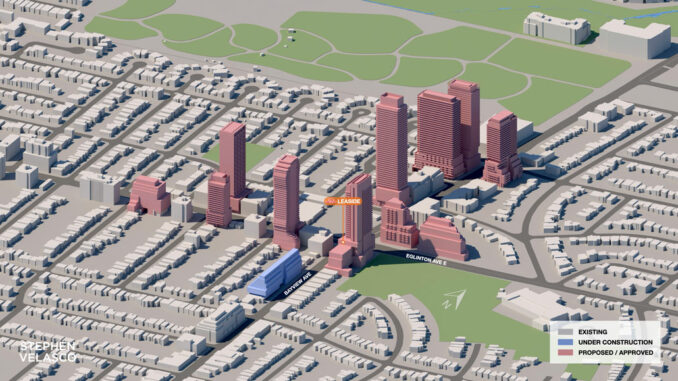
It’s time for an update on planning and development issues to cap last year and look forward to 2024.
Those of us who love Leaside know already that this is a unique community that deserves to be cared for and to evolve in a manner that is open to the future, yet builds on and embraces its roots.
It’s clear that Leaside, once known as a “stable community,” is in major physical upheaval with tall towers coming to the Focus Areas around the Leaside and Laird LRT stations, mid-rise on the avenues, and renovation/rebuilding in the neighbourhood. While the coming of the Eglinton LRT has been the underlying driver of change, we need to examine provincial and municipal government decision-making to really understand the dynamics of change. And while in previous updates we have noted Leaside’s “centre of gravity” moving north and east (Eglinton, east of Laird), more recent events will (eventually) also lead to major density on Leaside’s west side (Bayview and Eglinton).
Focus areas
The City initiated planning studies including Eglinton Connects and the Bayview and Laird Focus Areas Studies to address the expected land use impacts of the Eglinton LRT over 10 years ago. As such, up until fairly recently (2019) we can say that, despite several appeals to the provincial tribunal, in the main, development applications reflected City Council’s direction, following development and adoption of Focus Area plans, with extensive public consultation. The development applications and approvals we have seen on both Bayview and Laird south of Eglinton, and in Leaside East (Eglinton, Laird to Brentcliffe) have basically followed the massing, height and density limits proposed in plans approved by the City.
But things changed, at least for Bayview Avenue, after the City submitted the City Council-adopted Yonge Eglinton Secondary Plan (Official Plan Amendment OPA 405) to the province for approval, in 2018. When the province “returned” OPA 405, in June, 2019, it contained 194 changes, mostly increasing the permitted height limits, without any public (or even City) consultation. At Bayview and Broadway, for instance, the permitted height rose from eight to a mandated 20 to 35 storeys. Three months later, a developer submitted an application for a 25-storey tower on five properties they had assembled on the east side of Bayview south of Broadway. This was followed by eight other applications in the Bayview and Eglinton area for towers in the 25- to 46-storey range, one for the (expected) overbuild of the Leaside LRT station, three on the west side of Bayview, and four on Eglinton west of Bayview. Most of the developments have been appealed to the Ontario Land Tribunal, taking them out of the hands of the City to decide. We (the Leaside Residents Association) are now having to deal with these applications, along with the Broadway Area Residents Association (BARA), a newly emergent residents’ association on the west side of Bayview (north of Eglinton), and the South Eglinton Davisville Residents’ Association (SEDRA) (south of Eglinton).
To date, 1837-45 Bayview (at Broadway) is the only one of the nine OPA 405-related applications at Bayview and Eglinton the Ontario Land Tribunal has decided. Despite enormous effort and funds raised by the community, the Bayview Broadway Better Planning Group secured a three-storey reduction (from 25 to 22 storeys) – a far cry from what the City-adopted plan for the area would have yielded (max eight storeys). It appears that City Planning was unwilling to devote the time and effort required to fight the 1837-45 Bayview proposal, suggesting their acquiescence to the provincial override of the City’s adopted plan.
Neighbourhoods
The second area of change is in the Neighbourhoods-designated lands, with a City Planning program called Enhancing Housing Opportunities in Neighbourhoods (EHON). The planning framework is changing, with the elimination of restrictions allowing only single-family homes, and permitting denser housing typologies (the so-called “missing middle”), including laneway suites, garden suites and multiplexes with four units, and up to six storeys on “Major Streets.”
The Leaside residential neighbourhood is entirely built up and so far, we are not seeing much of this type of change. We know of one laneway house and one garden suite constructed in the area to date. We continue to see more applications for what amount to monster home rebuilds, rather than additional units (like multiplexes). More extensive change is possible if the Major Streets initiative is approved.
Minor variances and severances
The Committee of Adjustment continues to be as busy as ever with hearings every couple of weeks. The big change here is the provincial decision to eliminate residents’ right of appeal, while retaining that of the applicant (and the City). This makes participation of residents at the Committee of Adjustment that much more critical.
Heritage
The Province passed legislation (Bill 23) that will effectively eliminate listed properties from the Heritage Register on January 1, 2025 that are not designated under the Ontario Heritage Act in the meantime. Leaside has 11 designated properties, eight individually listed properties, including the Lea homes on Sutherland Drive and Heather Road, and 31 multiple listed properties on Bayview. The City is considering the listed properties on the Heritage Register (4,000+ properties) and will prioritize those most threatened with development. Designation reports involve extensive research, and lengthy approval processes. This makes it likely that many listed properties will lose their protection, and (reflecting a particularly vindictive streak in the provincial government) will not be eligible for listing again for five years.
It’s clear we are seeing unprecedented interventions by the Province that overrule the City’s plans, without further consideration for infrastructure requirements and both hard and soft services. Even changes proposed by the City have little real public engagement. (To be fair to Mayor Chow, she changed the 2024 City budget process and opened public consultation before, rather than only after the budget goes to committee!)
There continue to be two alternatives for Leaside: We can sleep-walk and leave the future of the community to the Province, the City, and the development industry; or we can inform ourselves and play a central role in planning the type of community we want and expect the City to foster. I know which one I choose.


